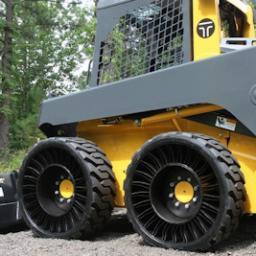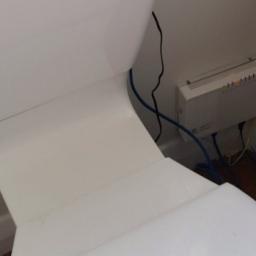DHS, the estranged megadepartment for which has suffered a series of setbacks in the last year, has once again made headlines for all the wrong reasons recently when
private information about a welfare recipient's financial affairs was released by the department in an attempt to counter the claims made about the debt recovery process used by DHS.The release of this information in this context is deemed to be
legally debatable by welfare advocates. When George Brandis was questioned about Centrelink's activities on the Q&A program he responded that people should just contact Centrelink, which caused the audience to
break out laughing as the current wait times and contact problems surrounding resolving debts issued by the Centrelink automated debt recovery system as seen by the public as being a farce.

If you've never driven a Tweel, it might be time to try one (or four). It is basically an
airless tire held up with rubber spokes. Michelin says the spokes provide a unique energy transfer that reduces bounce associated with pneumatic tires while offering two to three times the wear life. And because the tires have no air, you never have to adjust the air pressure or risk getting a flat. Tweels are best suited for low-speed vehicles that don't have suspensions and are prone to flats, such as lawnmowers and skid-steer loaders used on construction sites, but Michelin isn't ruling out their use on other vehicles in the future.
Different companies make
tires that don't use air, including Bridgestone and Goodyear, and they go by different names: Non-pneumatic tires (NPT), airless tires, or run-flat tire are the most common. The first time I drove NPT tires was in 2014, I was floored by how the tires absorbed the bumps and seemingly rolled without noise or resistance. The product manager talked about how these "Terrain Armor" NPTs won't go flat (punctures) and won't get stuck in mud because the honeycomb design actually pushes mud out. Of course, they also have some drawbacks, such as noise and vibration at higher speeds.

An ultrafast broadband installation that technicians have jokingly dubbed "fibre to the throne" has left New Zealand networking company Chorus red-faced. An optical network terminal (ONT) - where optical-fibre transitions to home wiring - was
installed on the back wall of a toilet in a Lower Hutt home with leads draped over the lid of the cistern. It shared a power socket with a washing machine and had to be plugged when that was in use.
In its annual report, TDR recounted a complaint it had received from a 71 year-old woman who was asked to stand on a hot water cylinder to plug in her phone. That was so technicians could troubleshoot a problem with her landline, after an ONT was installed in her hot water cupboard. Pullen said that case was an extreme and "bizarre" example of a wider issue of UFB installers placing equipment where it was convenient for them, rather than homeowners.
Chorus typically received about 10 "queries" on the 600 installs it arranged each day, Chorus spokesman Nathan Beaumont said. "Anyone who has any experience of building projects of this nature will know occasionally there will be snags."
Comcast, AT&T, Verizon, and others have created very favorable conditions for themselves, but in the fight for better broadband, more cities, towns, counties, and municipalities are building their own high speed networks. And many have been hugely successful. Sandy, Oregon became one of the first towns to start offering fiber internet without the help of a local power utility, and Madison, Wisconsin may become one of the first cities to build its own network and lease it to other operators.
There are startup internet service providers such as Ting and Brooklyn Fiber competing with incumbents. Rural power co-ops have found themselves well positioned to build fiber networks into sparsely populated areas without losing money, which was deemed impossible by big telecom companies who refused to invest in places without high population density. Even cities in states with legal barriers: Nebraska prevents cities laying their own fiber, so Lincoln built a conduit system-the tubes that actually hold the fiber-and is leasing that space to Allo Communications. Increasingly, these networks are being paid for with loans rather than federal government grants or taxpayer money, meaning the lenders see them as financially viable, long-term investments.
http://motherboard.vice.com/read/communities-are-taking-back-their-broadband-destiny-from-big-telecom
Seattle-based KIRO 7 news team recently took a pile of brand-new computers to six Office Depot locations around Portland, Ore. Technicians at four shops claimed the PCs showed "symptoms of malware," and offered to sell repair and protection services for up to $180.
Sister station FOX25 in Boston recently ran a similar undercover report, bringing three out-of-the-box PCs to Office Max, an Office Depot Inc. affiliate. Techs at two locations suggested signs of "poor performance," recommending a fix between $149 and $199; a third store found no problems. Washington Sen. Maria Cantwell last week requested that the Federal Trade Commission investigate Office Depot Inc. for deceptive or unfair marketing practices related to these allegations.
http://www.pcmag.com/news/349821/office-depot-caught-selling-fixes-for-non-existent-pc-probA New York University (NYU) student research team pushed the envelope for millimeter wave network range in a recently conducted field test in rural southwest Virginia. Setting up a millimeter wave transmitter on the porch of the country home of their professor Ted Rappaport, the students found that they could receive signals at distances of over 10 km (6.2 mi) even when line of sight was obstructed by a hill or a stand of trees. Equally significant, the millimeter wave transmitter
needed less than 1 watt (W) of power operating at 73 GHz.
The FCC in June opened 11 GHz of new spectrum in the millimeter wave band to network operators for the development of 5G technology. The results of the NYU student research team's field trial bode well for prospective carrier-grade applications, particularly regarding using existing cellular telecom infrastructure to provide 5G broadband services in underserved rural areas, according to Prof. Rappaport. The results could broaden industry participants' and regulators' perspectives regarding the use of millimeter wave technology
Others disagree with that conclusion. University of California, San Diego professor of electrical and computer engineering Gabriel Rebeiz pointed out that the field trial was conducted over two days when the skies were clear. Previous research has found that rain can reduce millimeter wave signal strength at a rate of 20 decibels per kilometer, the equivalent of nearly 100-fold per kilometer. Despite its potential in urban areas, Rebeiz still believes proposing to use millimeter wave technology in rural areas is a non-starter.
Google isn't a fan of non-standard approaches to fast-charging Android phones over USB-C, like Qualcomm's Quick Charge 3.0, and
it wants manufacturers to fall in line. The newest Android Compatibility Definition document says it's "strongly recommended" that device makers don't support proprietary charging technology that modifies voltages beyond standard levels, or otherwise creates "interoperability issues" with standard USB charging. The company warns that later versions of Android might even require full interoperability with standard chargers.
This doesn't mean that you won't see fast charging. Both of Google's Pixel phones can top up quickly. However, it's evident that Google would like to fulfill USB-C's promise of cables and chargers that always work together. It doesn't like the idea that you might have to carry a specific charger for your phone to work as expected, or that a flaky cable might fry your charger, phone or both.
Scientists have generated the
fastest electric current that has ever been measured inside a solid material. They made electrons in silicon dioxide oscillate with ultrafast laser pulses. The detected electric currents are approximately one million times faster than those widely used in a modern computer processor.
The researchers are also interested in exploring the physical limits: "As electrons move coherently they also generate light which is the key element of photonics. For this reason we may soon be able to unify two important areas of modern science and technology: electronics and photonics," Goulielmakis says. At the same time, the approach could pave the way for electronic devices which are one million times faster than those available today.
The possibility of having light replace conventional sources of electricity, such as batteries in order to generate electric currents inside solid materials, has captured the imagination of scientists for more than a century. The attempts to observe currents in solid materials by shining light on them have remained without any success for the past few decades. "Today, however, control of matter with lasers is rapidly advancing and the capability to measure light fields with ever finer precision has turned to reality."
Large-screen smartphones, a.k.a. phablets, are bigger than ever-especially in terms of popularity. Industry analyst IDC says more smartphones with 5.5-inch or larger displays are being sold than ever before, accounting for 33 percent of the phones sold in the U.S. this year. And the people who buy phablets use their phones more than consumers with smaller-screened models. The following phablets are among
the best large-screen models in Consumer Reports' ratings.
* OnePlus 3
* LG V10
* Moto Z Droid Force
* Samsung Galaxy S7 edge
* Apple iPhone 7 Plus
With the exception of the iPhone 7, all of these models support rapid charging, which can replenish a near-dead battery to about 50 percent capacity in less than a half-hour.


